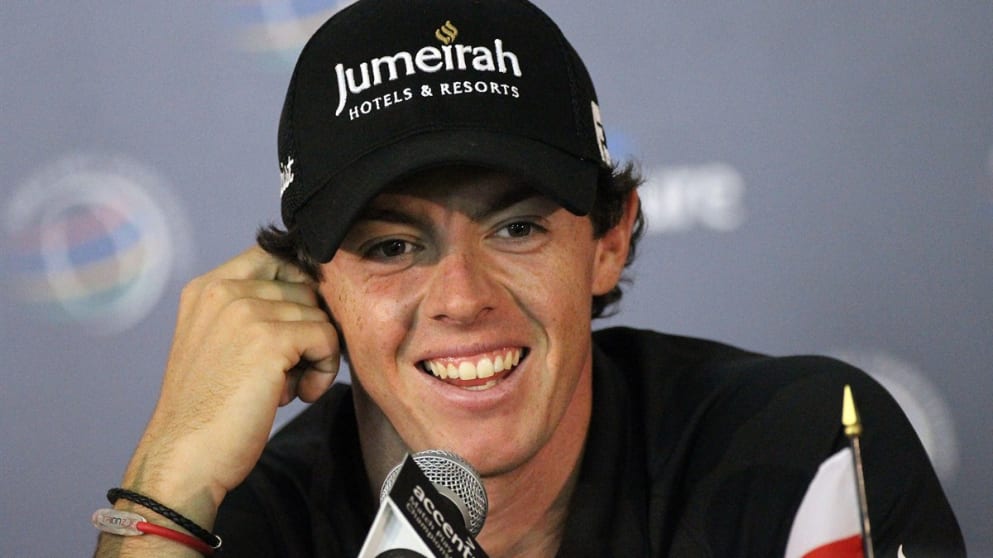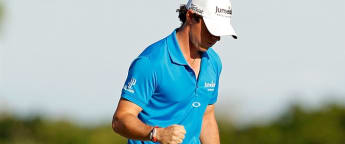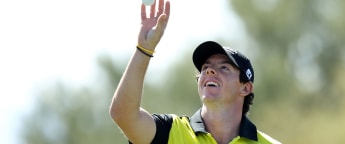As the new World Number One prepares to tee up alongside Luke Donald and Lee Westwood in the first two rounds of the WGC – Cadillac Championship, europeantour.com examines the 22 year old’s rise to the top of the world.

“He was holding a golf club before he could walk. He’d be sitting in the pram with a plastic golf club in his hand. That’s the way we were woken up in the morning: banged over the head with a plastic golf club!”
Rosie McIlroy’s son no longer wakes his mother and father, or anyone else for that matter, every morning by (lovingly) assaulting them.
In the 20 or so years since those daily attacks on Gerry and Rosie in their bedroom in Holywood, Northern Ireland, young Rory has learned to control his enthusiasm for the sport that crowned him its Number One exponent on Sunday night following his thrilling victory in the Honda Classic.
He has learned to control it, but that doesn’t mean his enthusiasm for the game he has mastered at the tender age of 22 has been diluted. Far from it.
McIlroy will rise every morning this week knowing he has achieved one of the main goals that has driven him to make the most of his precocious gift throughout his young life.
Interviewed by BBC Television in Northern Ireland when he was aged nine, McIlroy (rather squeakily) declared to the world that he wanted “to be the best player in the world and win Majors.”
No-one (apart from the three McIlroys) could have expected the nine year old to be a prophet as well as a prodigy, but Rory was soon accumulating golf trophies at a monstrous rate as he set about fulfilling the destiny that he himself had predicted.
Having been introduced to the game by Gerry when he was two, Rory picked up his first international title (just before his big BBC interview) at the World Under 10 Championships at Doral Golf and Country Club.
How fitting, therefore, that McIlroy is back at Doral for the WGC – Cadillac Championship where he will tee it up as the newly crowned World Number One for the first time later today (Thursday).
After his success in Miami 13 years ago, McIlroy went on to enjoy a sensational amateur career, the highlights of which included playing in the 2004 Junior Ryder Cup before winning the West of Ireland Championship (2005 and 2006), the Irish Close Championship (2005 and 2006) and the European Amateur Championship (2006).
His success at the European Amateur won him a place in the 2007 Open Championship at Carnoustie, and McIlroy duly announced his arrival on the world stage with a Silver Medal-winning performance as Padraig Harrington lifted the Claret Jug.
McIlroy turned professional days after his 2007 Walker Cup appearance and within weeks was a full card-carrying Member of The European Tour.
Having made his professional debut in the Quinn Direct British Masters (he finished tied 42nd), McIlroy produced a brilliant third place finish in the Alfred Dunhill Links Championship before tying for fourth at the Madrid Masters. The kid had secured his Tour card in the space of three tournaments and was ready to begin his quest to win Major Championships and top the Official World Golf Ranking.
By McIlroy’s ridiculously high standards, it took him a while to get going on Tour but, after a few months he found his feet and finished 36th in the Order of Merit at the end of the 2008 season. His 2009 campaign began with a second place finish at the Hong Kong Open (after a thrilling sudden-death play-off with Lin Wen-tang) that propelled him, for the first time, into the top 50 on the Official World Golf Ranking. A third place finish in the South African Open saw him cement his place among the world’s elite before he proved he belonged by securing his first professional victory at the Dubai Desert Classic.
There were no other wins in 2009, but there were further signs that McIlroy was on the path to fulfilling his prophecy as he tied for tenth place at the US Open and then third at the US PGA Championship.
He finished 2009 at Number Nine in the World Rankings and continued to progress over the next year, winning his first PGA Tour title with a sublime final round 62 at the Quail Hollow Championship, helping Europe regain The Ryder Cup at Celtic Manor and registering another two tied third place finishes at Majors - The Open (won by Louis Oosthuizen) and US PGA Championship (won by Martin Kaymer).
That level of performance saw McIlroy rise to a career-high of seventh in the World Rankings during the summer of 2010, but, despite reaching such dizzy heights in the space of just three years and at the tender age of 21, questions were being asked of his ability to win Majors and be crowned the greatest player in the world.
Was he a good enough putter? Could the short game stand up to pressure? Was he mentally tough enough? Did he work hard enough?
Those questions were being asked in some quarters even before McIlroy gave his doubters every reason to conduct the most severe of interrogations following the 2011 Masters Tournament. In what is now commonly referred to as ‘Rory’s Maters Meltdown’, McIlroy took a four shot lead into the final round at Augusta National before coming apart under the most intense spotlight in golf: the last nine holes in the final round of a Major Championship.
While no-one can take anything away from Charl Schwartzel’s rousing finish of four consecutive birdies to take home the Green Jacket last year, McIlroy knew he had thrown away a golden opportunity to win his first Major. Instead of answering his fiercest critics, he gave them petrol to throw onto the fire.
McIlroy had looked uncomfortable from the moment he had stepped on to the first tee on that hot Augusta Sunday afternoon, but it wasn’t until the start of the back nine that his challenge unravelled. By the time he lost control of his drive on the 13th tee, he knew his tournament was over. It is difficult to forget the image of McIlroy slumped over his golf bag, all of a sudden looking every bit the vulnerable kid.
"I definitely felt like crying because the drive on the 13th was the one that took all my chances away," he says. "But I didn't actually cry until the next morning, when I spoke to my mum and dad. I spoke to them before I went to the airport on the Monday.
“My mum said something like: 'Oh don't worry Rory, everything will be OK,' and I just blubbed back: 'No, it won't be OK!' It was one of those things. There were so many thoughts and emotions going through my head. At the time it felt like the only chance I would have of winning at Augusta and I blew it."
What would McIlroy’s response be to the darkest moment of his career?
After courageously facing the world’s media in the immediate aftermath of his Augusta nightmare, McIlroy took a step back from the game and got some perspective.
It didn’t take long for him to respond to the critics. Eight weeks after his Augusta horror show, a refocused, finely-tuned McIlroy destroyed the field at the US Open, winning by eight clear strokes with a 16 under par aggregate of 268, the lowest winning score in the tournament’s history.
As McIlroy completed his 268th shot of the week at the Congressional Country Club, he greeted Gerry with a warm embrace on the 18th green. “It was important to have my dad there that week,” said McIlroy. “He kept me calm, he said all the right things – things that were more reassuring coming from the person who knows you better than anyone else in the world.
“Part of the motivation I had at the US Open was trying to prove something to myself, that I wasn't one of those players who crumbles under the pressure, who folds, or chokes,” he explained. “I hate using the word choke but that's exactly what happened at the Masters. I also wanted to prove people wrong, whether it was the Media or just critics in general. I wanted to show them that the person they saw on Sunday at Augusta was not the real Rory McIlroy.”
Now that the real Rory McIlroy had stood up, he set about that other childhood goal of his: becoming World Number One.
Given the imperious manner of his US Open victory, there was no longer a debate as to McIlroy’s ability to be the best on the planet – the only question that remained unanswered was whether or not the Northern Irishman could match the formidable and downright domineering consistency that had made Luke Donald the undisputed Number One since his BMW PGA Championship victory at Wentworth in May.
Having moved to Number Four in the World Ranking after the US Open, McIlroy took four weeks off before a turbulent month saw him finish in a tie for 25th at The Open, quickly followed by an injury to his wrist during the first round of the US PGA Championship which brought his Major season to an end.
His final push in the quest to overhaul Donald at the top of the World Ranking was just beginning though, as he embarked on a seven-month run of form that would see him win three times and finish outside the top five just once in any event he has played, at the Dubai World Championship presented by DP World in December, where he finished 11th.
That remarkable run of form, that saw him win the Shanghai Masters (October), the Hong Kong Open (November) and last week’s Honda Classic, was good enough to fulfill the prophecy of that crazy nine year old kid who used to whack his parents around the head with a set of plastic golf clubs.
Rory McIlroy: Major Champion and World Number One.









